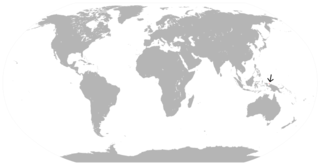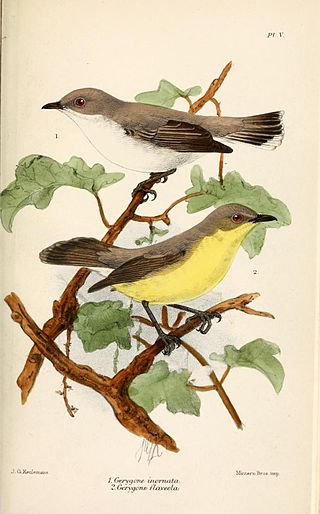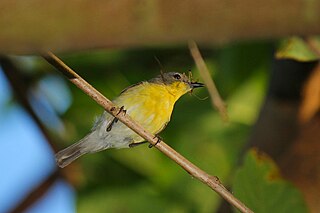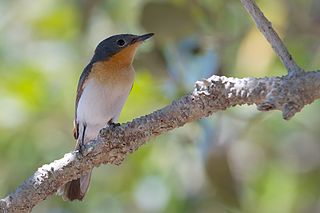
The red-breasted goose is a brightly marked species of goose in the genus Branta from Eurasia. It is currently classified as vulnerable by the IUCN.

The brown-necked raven is a larger bird than the carrion crow though not as large as the common raven. It has similar proportions to the common raven but the bill is not so large or deep and the wings tend to be a little more pointed in profile. The head and throat are a distinct brownish-black giving the bird its English name, while the rest of the plumage is black glossed with purple, blue or purplish-blue. Like the common raven, thick-billed raven and white-necked raven, it is one of the larger raven species. The feathers of this species often fade quite quickly to a brownish black and the bird can look distinctly brown by the time it moults. The feet, legs and bill are black. The dwarf raven was formerly considered a subspecies but this bird now appears to be closer to the pied crow than this species.

The red-necked stint is a small migratory wader. The genus name is from Ancient Greek kalidris or skalidris, a term used by Aristotle for some grey-coloured waterside birds. The specific ruficollis is from Latin rufus, "red" and collum, "neck".

The brown gerygone, previously known as the brown warbler, is a small passerine bird native to eastern coastal Australia. The upper parts of the brown gerygone are a deep olive-grey or olive-brown, while its face and underparts are a much paler grey, cream, or washed-out brown. The tail feathers are dark and may be white-tipped. It is approximately 10 cm in length.

Gerygone, the gerygones or peep-warblers, is a genus of bird in the family Acanthizidae. The genus ranges from Southeast Asia through New Guinea and Australia to New Zealand and the Chatham Islands. Most of the species are found in Australia and New Guinea; only one, the golden-bellied gerygone, has managed to cross Wallace's Line and colonise as far as Thailand, Malaysia and the Philippines.

The yellow-bellied gerygone is a species of bird in the family Acanthizidae. It is found in New Guinea. Its natural habitat is subtropical or tropical moist lowland forests.

The grey thornbill, ashy gerygone or mountain gerygone is a species of bird in the family Acanthizidae. It is found in the New Guinea Highlands. Its habitat includes subtropical and tropical moist montane forests.

The rufous-sided gerygone is a species of bird in the family Acanthizidae. It is found in the eastern Lesser Sunda Islands and Kai Islands.

The fan-tailed gerygone is a species of bird in the family Acanthizidae. It is found in New Caledonia and Vanuatu. The Rennell gerygone of the Solomon Islands was formerly considered conspecific, but was split as a distinct species by the IOC in 2021.

The Biak gerygone is a species of bird in the family Acanthizidae. It is endemic to the islands of Biak and Supiori in West Papua, Indonesia.

The plain gerygone is a species of bird in the family Acanthizidae. It is found on the islands of Wetar and Timor. Its natural habitats are subtropical or tropical moist lowland forest and subtropical or tropical mangrove forest.

The Lord Howe gerygone or Lord Howe gerygone flyeater was a small bird in the family Acanthizidae, brown and greyish in color. Its head was brown apart from a pale grey eye-ring and a grey throat and chin, many parts of the animal varied to the colour of yellow, this being apparent in its bright yellow belly. It made its home in the canopies of the island's forest until the early 20th century. The bird has had a variety of monikers: locally, it was known as the "rain-bird" due to its activity after the rains, or the "pop-goes-the-weasel", due to the similarity of its song to the well-known tune. The bird was endemic to Lord Howe Island in the Tasman Sea. There have been no records of the species since 1928, and it is considered to be extinct. Its extinction is almost certainly due to predation by black rats which were accidentally introduced to the island in 1918 following the shipwreck of the SS Makambo there.

The mangrove gerygone is a species of bird in the Australian warbler family Acanthizidae. The species is also known as the mangrove warbler. The species is thought to form a superspecies with the closely related fan-tailed gerygone of Melanesia and the Australian western gerygone. There are three subspecies of mangrove gerygone, G. l. pallida, found in southern New Guinea, the nominate race G. l. levigaster, which is found from coastal Western Australia to coastal north Queensland, and G. l. cantator, which is found from coastal Queensland to New South Wales. The species is uncommon in New Guinea and has suffered some declines due to mangrove clearances but is not considered threatened by the IUCN.

The Norfolk gerygone is a species of bird in the family Acanthizidae. It is endemic to Norfolk Island.

The white-throated gerygone is a species of bird in the family Acanthizidae. It is found in Australia and Papua New Guinea. Its natural habitats are temperate forests and subtropical or tropical moist lowland forests. Its common names include white-throated warbler, white-throated flyeater, bush canary, and native canary.

The fairy gerygone, previously known as the fairy warbler, is a species of bird in the family Acanthizidae native to New Guinea and Queensland.

The golden-bellied gerygone is a species of bird in the family Acanthizidae. It is found in Brunei, Indonesia, Malaysia, the Philippines, Singapore, and Thailand. Its natural habitats are subtropical or tropical moist lowland forest and subtropical or tropical mangrove forest.

The dusky gerygone is a species of bird in the family Acanthizidae. It is endemic to coastal central and northern areas of Western Australia.

The broad-billed flycatcher is a species of bird in the family Monarchidae. It is found in northern Australia, the Lesser Sunda Islands and southern New Guinea. Its natural habitats are subtropical or tropical moist lowland forest, subtropical or tropical mangrove forest, and subtropical or tropical moist montane forest.

The large-billed gerygone is a species of bird in the family Acanthizidae found in northern Australia and New Guinea.



















